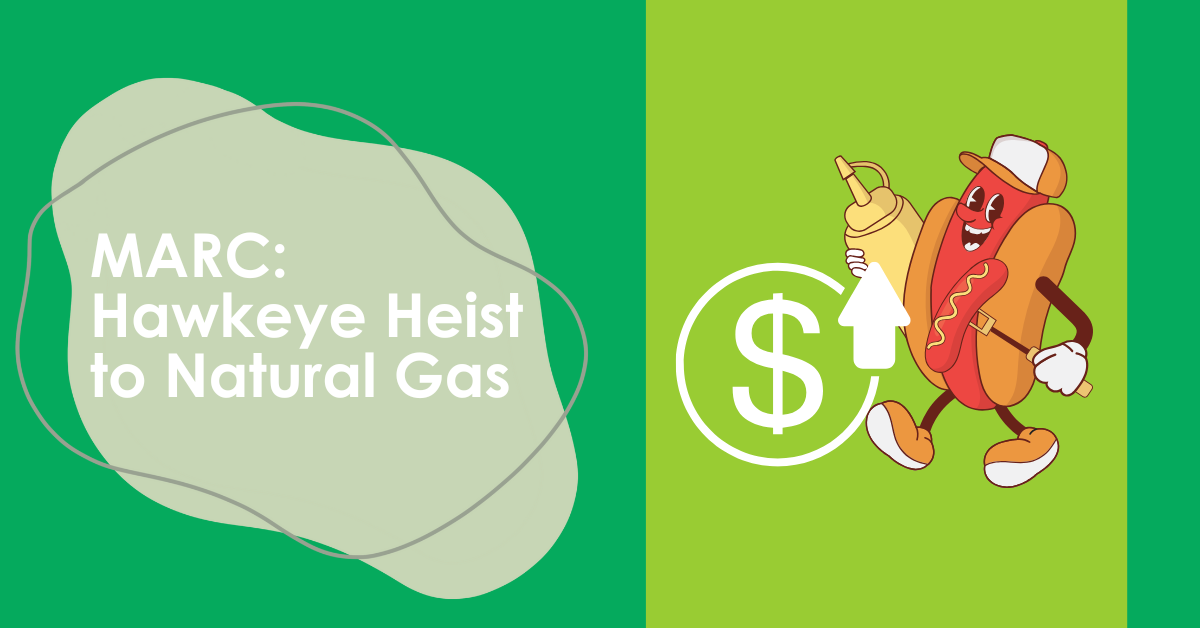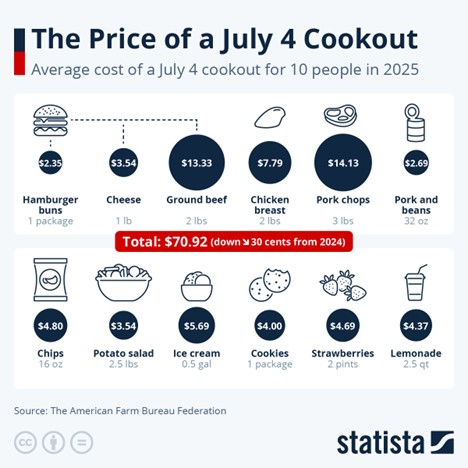
During one of my weekend rituals of reading ZeroHedge over lunch, I noticed this article detailing The (Falling) Price Of A July 4th Cookout. It featured Figure 1 from Statista. Although I think it’s impressive that the feast can be purchased for $7 per head, my brain went to the more interesting statistics. Wow, that is a ton of food and calories for 10 people! – 1,865 per person, says Sam Altman, OpenAI / ChatGPT. See the breakdown in Figure 2. Pass the watermelon. Thank you.
Figure 1 Cookout Cost for Ten
 Figure 2 Cookout Caloric Breakdown
Figure 2 Cookout Caloric Breakdown
 I know what you’re thinking. How many calories did Joey Chestnut put away with his 70.5-dog triumphant return to the winner’s circle at Nathan’s Famous hot dog eating contest last Friday? 20,455. He doesn’t need to eat for a week. By the way, that announcer dude that Nathan’s has for the show is a fantastic showman.
I know what you’re thinking. How many calories did Joey Chestnut put away with his 70.5-dog triumphant return to the winner’s circle at Nathan’s Famous hot dog eating contest last Friday? 20,455. He doesn’t need to eat for a week. By the way, that announcer dude that Nathan’s has for the show is a fantastic showman.
The Hawkeye Heist
Moving on with the Mid-America Regulatory Conference, I start with recent postings relevant to my praise of MidAmerican Energy’s focus and success in keeping electric rates low to lure large energy users to Iowa and their service territory.
The Wall Street Journal Editorial Board, which I love to roast frequently, commented on the One Big Beautiful Bill passed by the Senate and signed into law. The EB applauds cementing current tax rates “permanently,” while they berate the extension of the “post-Covid welfare state.” The EB welcomes the end of the wind and solar tax credits, but laments that “Republicans from windy Great Plains states extracted a two-year extension of the IRA’s biofuels tax credit. Call it the Hawkeye Heist.” That gave me a chuckle. I must say that only a foolish businessperson would pass on goodies made available by whatever policy, even if they disagree with it, especially when people from 50 states subsidize the cost of goods sold to their customers.
Iowa has always had outsized political pull, I believe, because the Iowa caucuses kick off the quadrennial presidential sweepstakes. Sam Altman agrees, leading off with
“#1: First-in-the-Nation Caucus Privilege
- “Iowa hosts the first presidential caucus, which gives its voters early kingmaker status.
- “Candidates campaign heavily, making promises to support local industries like ethanol and wind to win early momentum.
- “Result: Even national politicians back policies favorable to Iowa to curry favor.”
The State of Natural Gas
In other news, utilities are going full speed ahead with natural gas for end users and power generation. Somali Tomczak with Nicor Gas mentioned they add 11,000 new meters (meaning, gas service, not including meter replacements) in Northern Illinois annually. Giant energy users, including industrial, manufacturing, and data centers, are among those receiving new gas service. Ironically, the first time I heard “data centers” at the conference was in this Innovations in Natural Gas session.
You may wonder why a data center would want natural gas service. That’s pretty easy to see considering power constraints in places like Virginia, where some developers must add their own power generation. Some data center developers in Northern Illinois are connecting to enough natural gas supply to provide 500 MW of prime power. There’s an idea to keep capacity charges at bay!
Data center developers aren’t the only ones pursuing natural gas for power generation. I noted back in April that Meta in Louisiana and Google in Wisconsin are making huge investments where their electric utilities, Entergy and WEC Energy Group, respectively, will power their operations with natural-gas-sourced electricity. Entergy’s plants will be efficient combined-cycle while WEC’s will be inefficient simple gas-turbines.
With all that background in my brain, I had the fortune to sit next to Shane Alexander, Director of Damage Prevention with CenterPoint Energy natural gas. I asked him about the capacity to serve all these new natural-gas power plants coming online. He said there is plenty of pipeline capacity, augmented by underground storage facilities, to fuel new power plants in the queue, at least in the Midwest.
Natural gas is not only going strong in the middle of the country. A couple of months ago, I spoke with a senior representative in operations with National Grid, Massachusetts, which is quietly investing beaucoup millions into natural gas infrastructure. Meanwhile, Interior Secretary Doug Burgum struck a deal with New York Governor Kathy Hochul to swap offshore wind for natural gas pipeline expansion in the state.
Wrapping up, American Gas Association representative, Ashley Duckman, noted at least three times that the energy supply can only be decarbonized as fast as customers can afford it. This sounds familiar, like here, here, here, and, for sure, here. Decarbonization and electrification must make sense in dollars and cents, or add other convenience benefits, like manufacturing bottleneck mitigation.
Hearing the Silent
Panelists in the Public Engagement and Regulatory Culture session provided insights for balancing customer and stakeholder voices and priorities. Clair Moeller, former COO of the Midcontinent Independent System Operator, noted that “[people] educated with a voice have an outsize share of audience.” I wrote that he’s talking about our industry and a good share of state and local governments focusing on decarbonization and electrification, with insufficient consideration of grid reliability or customer costs. However, sometimes we need to spend a little money to avoid wasting more, considering all the costs to make it happen are expensive.
Andrew Velainis with the Regulatory Assistance Project and Sarah Moskowitz with the Citizens Utility Board of Illinois added that some parties always attend public hearings. Some show up several times a year, and those who need affordable energy the most are never there. Regulators and consumer advocates must hear the silent voices.
Next Up
Next week, I’ll wrap up my coverage of the Mid-America Regulatory conference with the latest on nuclear power potential, rates, load management, and economic development.
